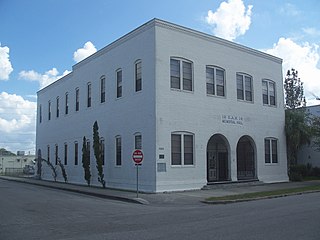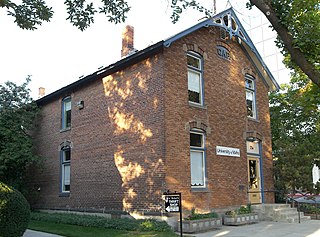
The Grand Army of the Republic (GAR) was a fraternal organization composed of veterans of the Union Army, Union Navy, and the Marines who served in the American Civil War. It was founded in 1866 in Decatur, Illinois, and grew to include thousands of "posts" across the North and West. It was dissolved in 1956 at the death of its last member, Albert Woolson.

The New England Civil War Museum and Research Center was originally started by local Civil War veterans in 1896. It was not until March 1994 that it was formally established as a museum and opened to the public. It is located within the Memorial Building, inside a former Grand Army of the Republic (GAR) Hall in Rockville, Connecticut. Thomas F. Burpee Post #71 of the Grand Army of the Republic held their meetings in the Grand Hall from 1890 until 1929. Alden Skinner Camp #45 of the Sons of Union Veterans of the Civil War, their direct heir, have held their monthly meetings in the hall since 1890, making it the oldest, continuously used GAR Hall in the entire country.

The Grand Army of the Republic (GAR) Building is a historic building in downtown Detroit, Michigan. It was listed on the National Register of Historic Places in 1986.

The Grand Army of the Republic Memorial Hall is an historic building located at 1101 Massachusetts Avenue in St. Cloud, Florida, in the United States. The city of St. Cloud had been founded by the Grand Army of the Republic or GAR, as a retirement colony for its members. The hall was built in 1914 by members of the GAR as a memorial to the Union Army veterans of the Civil War. It was one of many such halls built in the country. On February 21, 1997, it was added to the U.S. National Register of Historic Places.
Grand Army of the Republic Hall, GAR Building, or variants thereof, may refer to:

The Grand Army of the Republic Hall is an historic Grand Army of the Republic building located at 714 W. State Street in Boise, Idaho.

The Grand Army of the Republic Memorial Hall, also known as William Baumer Post No. 24, Grand Army of the Republic (GAR), and the Civil War Veterans Museum, is a historic building located at 908 1st Corso in Nebraska City, Nebraska, in the United States. The hall was built in 1894–95. In 1994, it was added to the U.S. National Register of Historic Places.

The Grand Army of the Republic Hall, also known as John M. Hagadorn Post No. 505, Grand Army of the Republic and the Schuyler F. Smith Camp No. 193, Sons of Union Veterans of the Civil War, and Halsey Valley Grand Army of the Republic Meeting Hall, is an historic building located on Hamilton Valley Road in Halsey Valley near Spencer, New York, in the United States. The hall was built in 1894 and on January 23, 2003, it was added to the U.S. National Register of Historic Places.

The Grand Army of the Republic Hall, also known as the General Frederick W. Lander Post No. 5, Grand Army of the Republic, is an historic building located at 58 Andrew Street in Lynn, Massachusetts, in the United States.

The Grand Army of the Republic Hall is an historic building located at 23 East Downer Place on Stolp Island in Aurora, Illinois, in the United States.

Grand Army of the Republic Hall, also known as the Grand Army of the Republic Memorial Hall, was an historic brick building located at 14 Prospect Street in Orange, Massachusetts in the United States. The hall was built by members of the GAR as a memorial to the Union Army veterans of the Civil War. It was one of many such halls built in the country. It is a contributing property in the Orange Center Historic District.

The Franklin County G. A. R. Soldiers' Memorial Hall, also known simply as the Soldiers' Memorial Hall, is a historic building located in Hampton, Iowa, United States. The octagonal-style structure was designed and built in 1890 by Edward Carl Keifer. It was the meeting place of the J.W. McKenzie Post No. 81, Grand Army of the Republic (G.A.R.), which was one of 519 GAR posts in Iowa. The building is architecturally significant as it is one of the few examples of a Gothic Revival style structure of this type in the area. It is a memorial chapel that follows a cross-shaped plan capped by an octagonal cupola with a statue of a Union soldier on top. Its significance is also derived from it being the first G.A.R. Memorial Hall built in Iowa. The Iowa legislature had passed a law in 1884 that allowed counties to levy a tax to support building G.A.R. memorials. Captain Rufus S. Benson, a local state representative, had the law amended in 1886 so that it allowed for the construction of a memorial hall, as the local G.A.R. chapter wanted it to be a place where they could meet.

The Lothrop Memorial Building-G.A.R. Hall is an historic building located at 95 Washington Street in Taunton, Massachusetts. It was originally built in 1888 as the First Presbyterian Church, on land purchased from Marcus Morton, and now houses professional offices. It was for many years home to the William H. Bartlett GAR Post No. 3 of the Grand Army of the Republic, a veterans organization, which ran the building as a community center. It was added to the National Register of Historic Places in 1984.

The G.A.R. Hall and Museum is a historic museum at 58 Andrew Street in Lynn, Massachusetts.

The Stephenson Grand Army of the Republic Memorial, also known as Dr. Benjamin F. Stephenson, is a public artwork in Washington, D.C. honoring Dr. Benjamin F. Stephenson, founder of the Grand Army of the Republic, a fraternal organization for Union veterans. The memorial is sited at Indiana Plaza, located at the intersection of 7th Street, Indiana Avenue, and Pennsylvania Avenue NW in the Penn Quarter neighborhood. The bronze figures were sculpted by J. Massey Rhind, a prominent 20th-century artist. Attendees at the 1909 dedication ceremony included President William Howard Taft, Senator William Warner, and hundreds of Union veterans.

The Grand Army of the Republic Memorial Hall, built in 1892, is an historic building located at 401 Railroad Street in Ironton, Ohio. Designed by noted Ohio architect Joseph W. Yost in the Richardsonian Romanesque style of architecture, it was built to serve as a Grand Army of the Republic memorial and the meeting hall of Dick Lambert Post No. 165 of the GAR. It later served as the meeting hall of the now long-defunct American Legion Post No. 59 as well as the Ironton city hall. After being abandoned by the city, American Legion Post No. 433 undertook the task of restoring the long neglected veteran's memorial. On September 19, 2012, the building was added to the National Register of Historic Places. On May 28, 2014, demolition of the building began.

The Black Hawk County Soldiers Memorial Hall, also known as Veterans Memorial Hall, is a Classical Revival veterans hall located at 1915 Courbat Ct. in downtown Waterloo, Black Hawk County, Iowa. It was built starting in June 1915 and first meeting was held there in December of the same year by the Grand Army of the Republic as a memorial to soldiers who died in the American Civil War. It was listed on the National Register of Historic Places in 1988 due to its architecture and importance in local history.
Stumbaugh Post No. 180 GAR Hall, also known as Austin Community Hall, was a historic Grand Army of the Republic hall located at Austin, Cass County, Missouri. It was built in 1893, and is a one-story, T-shaped frame building. It has a gable roof and displays little ornamentation, typical of rural vernacular buildings. From 1892 to 1911 the building served the local chapter of the Grand Army of the Republic (G.A.R.) as the veterans meeting hall. It was used as a community center until 1996.


















